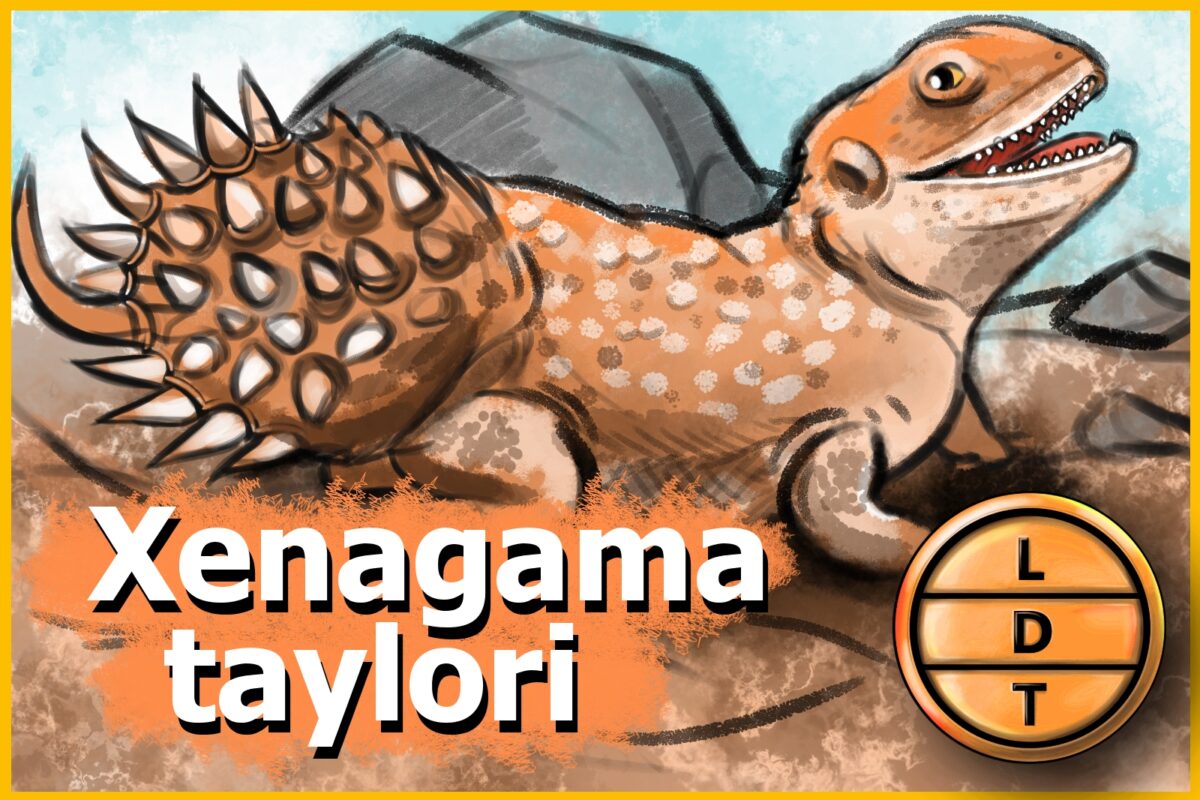“…and today we’re talking about a spike-covered tush that lives out in the bush. But more on that later.”
The subterranean lifestyle has it’s benefits and many small animals make their beds below the earth. From the sleeping cicada to the idle fox, the shelter of a sand and soil roof provides protection from predatory prowlers. But there’s one flaw in this tactic. What if someone or something can fit in your hiding place? The shield-tailed agama isn’t willing to leave any attack unprepared for. He’s developed an interesting way to enter dreamland free of the fear of tunnel-going hunters. But covering all your bases is one way to beat insomnia in Life, Death, and Taxonomy.
Description
- Looks like a typical bearded dragon with elements of horny toad
- It’s a lizard with a large head, wide body, and short arms and legs
- It’s scales are spiny and are a mottled brown and tan color
- It has two large ear holes on either side of its skull
- However, males will sometimes have their throats turn bright blue during mating season.
- Adolescents will sometimes have white spots, but these fade as they age
Measure Up
Welcome to the beloved Measure Up segment. The official listener’s favorite part of the show! The part of the show when we present the animal’s size and dimension in relatable terms through a quiz that’s fun for the whole family. It’s also the part of the show that’s introduced by you when you send in audio of yourself saying, singing, or chittering the words Measure Up into ldtaxonomy at gmail dot com. We don’t have a new Measure Up intro this week.
- Atlas Day Gecko
- Barn Owl
- Cane Toad
- Douglas Squirrel
Length
- 3 to 3.5 inches (8.8 cm)
- How many agamas go into the distance away you can clearly hear the largest air horn in the world?
- Hint: This isn’t necessarily an official record but I can’t find a bigger air horn. It was made by Mark Rober, a former NASA engineer that has a Youtube channel where he makes crazy things including a giant super soaker. It took 8 months to make. They could clearly hear the horn standing far enough away for it to take more than 10 seconds for the sound to get there. It was even able to shatter glass.
- 45,720 lizards. Rober was able to hear it clearly standing 2.5 miles away.
Weight
- 20 grams
- How many agamas go into the weight of coffee that’s produced by Ethiopia per year?
- Hint: Ethiopia’s elevation and climate make it one of the world’s top coffee producers. The United States buys around 11% of the country’s total coffee exports.
- 10 billion agamas. Ethiopia produces around 200,000 metric tons of coffee annually.
Fast Facts
- Range: Lives in the horn of Africa, the eastern section of the continent including eastern Ethiopia and Somalia. It likes flat, semi-arid desert regions where it can dig burrows. Temperatures can reach up to 122 F.
- It was discovered in the 1930s by a British army officer named Captain Taylor
- Diet: Insects, grass as well as local fruits and berries
- Behavior: males tend to hang out with a small harem of 2-5 females
- Behavior in the wild is not readily available since these are most commonly kept as pets
Major Fact: The Aegis Posterior
Shield-tailed agamas have a rear that’s unlike most reptiles. Instead of a long scaly tail, their butts end in a spikey ball.
The round spike ball right behind their back legs is about the width of their heads. They also have a small tail that emerges from the back of the spike ball, but it’s clear that it’s not their behind’s main attraction.
The lizard lives in flat arid regions, so that means there isn’t an abundance of rocks, sidewalk cracks, and logs to hide under. They will dig shallow burrows in the soil and dart into them head first when they’re disturbed.
Following the lizard into the borough isn’t a good idea for slender predators. The agama’s sikey tail plugs the tunnel behind him, allowing the lizard to cover its own six.
At night, they’ll sleep at the entrance to their burrows with their tails blocking the opening.
Ending: So regulate your internal temperature, keep your blue chin up and always use your turnip-shaped bum to shut the front door like the shield-tailed agama here in LDT.

